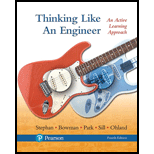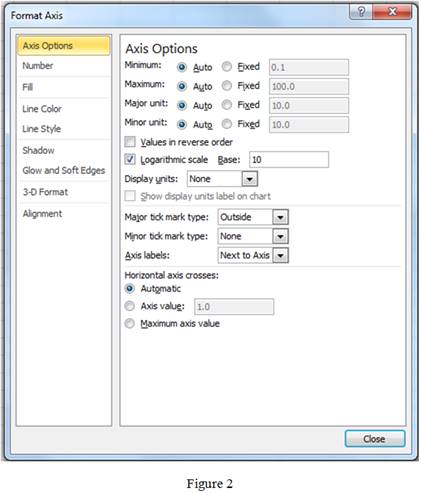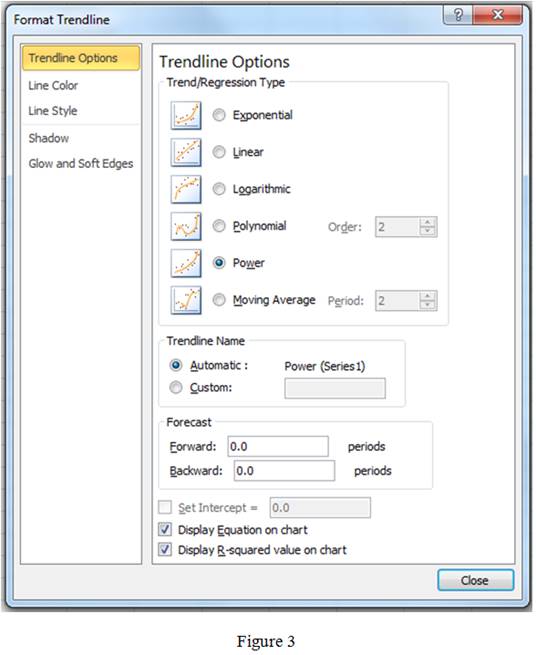
Capillary action draws liquid up a narrow tube against the force of gravity as a result of surface tension. The height the liquid will move up the tube depends on the radius of the tube. The following data were collected for water in a glass tube in air at sea level. Show the resulting data and trendline with equation and R2 value, on the appropriate graph type (rectilinear, semilog, or log–log) to make the data appear linear

Show the resulting data and trend lines with equation and
Answer to Problem 1ICA
The data and trend line with equation and
Explanation of Solution
Description:
Step 1: Open the Excel Sheet, and enter the data as shown in Figure 1.

Step 2: Select all the data from columns Radius and Height.
Step 3: Now, go to the Insert tab in the Excel and click on the Scatter Plot.
Step 4: Change the property of the plot to get the linear plot as follows.
- Click on the y-axis, select format axis as shown in Figure 2.

- Similarly, click on the x-axis and format the axis.
Step 5: Click on points and add trendline as shown in Figure 3.

Step 6: Label the axis of the plot properly as per the format shown below.
Step 7: Mention the title of the plot as shown in Figure 4.

Conclusion:
Hence, the data and trend line with equation and
Want to see more full solutions like this?
Chapter 13 Solutions
Thinking Like an Engineer: An Active Learning Approach (4th Edition)
- What mathematical relationship exists between the wave speed and the density of the medium, using the POWER trendline equation from the graph? Make your response specific (i.e., describe the full mathematical proportionality between the two variables) Feel free to use the table. Table: Frequency (Hz) Density (kg/m) Tension (N) Speed (cm/s) Wavelength (cm) 0.85 0.1 4.0 632.5 744.12 0.85 0.7 4.0 239.0 281.18 0.85 1.3 4.0 175.4 206.35 0.85 1.9 4.0 145.1 170.70arrow_forward(3) Use the following graph to answer the questions on this page. The total time is 0.4 seconds. Area of a triangle = 0.5 × base × height vertical 1500 .... horizontal 500 time (s) 0.2 -1000 (a) The subject has a body weight of 1000 N. What is the horizontal impulse generated, total vertical impulse generated, and net vertical impulse generated? Show all of your work for full credit (b) If mass is -100kg, what is the change in horizontal and the change in vertical velocity? Reaction Force (N)arrow_forwardTime left 1:5 An ideal gas has its pressure (1.8) times and mass density (2.2) times increased. If the initial temperature is 265.4 °C, what is the final temperature in °C, and use one number after the decimal (xxx.x)? Answer: NEXT PAGE pe here to search DELLarrow_forward
- As we explained in earlier chapters, the air resistance to the motion of a vehicle is something important that engineers investigate. The drag force acting on a car is determined experimentally by placing the car in a wind tunnel. The air speed inside the tunnel is changed, and the drag force acting on the car is measured. For a given car, the experimental data generally is represented by a single coefficient that is called drag coefficient. It is defined by the following relationship: F, where air resistance for a car that has a listed C, = drag coefficient (unitless) measured drag force (N) drag coefficient of 0.4 and width of 190 cm and height of 145 cm. Vary the air speed in the range of 15 m/sarrow_forwardThe velocity of the fluid flowing in a pipe with a radius of 10 cm was measured at certain points and the following table values were obtained. r=the distance of the measurement points to the center of the pipe (m) v=measured speeds (m/s) Accordingly, calculate the velocity value for r = 0.07 m by using 3rd order interpolation with the help of appropriate points that make the error minimum. In calculations, take 4 digits after the comma.arrow_forwardAs the potential across the resistor increased, the current through the resistor increased. If the change in current is proportional to the voltage, the data should be in a straight line and it should go through zero. In these two examples how close is the y-intercept to zero? Is there a proportional relationship between voltage and current? If so, write the equation for each run in the form potential = constant x current. (Use a numerical value for the constant.)arrow_forwardEnergy of a Roller Coaster Car 500 450 400 350 --- 3 300 250 E 200 150 100 50 6 8 10 Time (s) Mechanical Energy ....... Potential Energy -- Kinetic Energy This graph shows different types of energy for a roller coaster car that starts at the top of a large hill and goes down to its lowest point at 6 s. According to the graph, what is the most likely relationship between height and potential energy? Your answer: They are directly related. They are inversely related. There is no relationship between the two. There is not enough information for a conclusion.arrow_forward1. For the following concentration expressions, indicate whether they are uniform or nonuniform and in how many dimensions (OD, 1D, 2D, or 3D), and steady or unsteady. Then for the following control volume and origin, and table of constants, use Excel or Matlab to graph profiles that show how concentration changes within the control volume and over time to a limit of 20 for the following: C(x,0,0,0), C(0,y,0,0), C(0,0,z,0) and C(0,0,0,t). On each graph, show which parameters are held constant, the CV boundaries, and the point where all four plots overlap. 20 C(x=0) 10 a 0.0001 b 0.001 | 20 0.01 k 0.1 100 All of the following functions are C(space, time) and so not necessarily just x as suggested. a. C,(x)= C,(x = 0)x exp{- ax}arrow_forwardThe traffic volume data table below counts was taken on rural a highway during the morning peak hour at (8:00-9:00 am) on Monday of a week. Time periods (minute) 8:00-8:15 AM 8:30-9:00 AM Number of vehicles 385 790 The average time headway (sec) during 8:00-9:00 am 2.25 a) Find the traffic volume for the period from 8:15 to 8:30 am. b) Determine the hourly volume (HV), the maximum rate of flow within the hour, and the peak hour factor (PHF). c) Estimate the density and speed of traffic if an average spacing of 150 ft. d) Estimate the daily volume for Monday if the hourly expansion factor (HEF) is 22.05.arrow_forwardWater X 50-mm inside diameter The volume flow rate of the system The pressure at the point "A" The pressure at the point "B" 25-mm diameter As a consultant at one of the country's leading soft drink companies, you are tasked with evaluating the system depicted to determine the following parameters using Bernoulli's Equation if the values assigned to "X" and "Y" are 3m and 0.5m respectively: i. ii. iii.arrow_forwardA snowboarder’s velocity is tracked by a pulse-laser velocimeter as she descends the slope. These velocity data are stored and analyzed via an embedded curve fitting procedure to determine a velocity function of v(t) = 1.5t2 + 2t + 2 (t is time in seconds and v is velocity in ft/s). At time equal 0, position (x) is zero. Find her position (e.g., distance traveled), velocity and acceleration formulations and values of each when time equals 15 seconds. Clearly write the formulas before finding respective values at t = 15 seconds!arrow_forwardCheck the following equation for dimensional homogeneity: mu = (Fcos) at where m is mass, v is velocity, F is force, is an angle, and it is time. Check that each term in the equation has the following dimensions: [MOLT] where you are to choose the coefficients a, b, c. Answers: b= C= i iarrow_forwardarrow_back_iosSEE MORE QUESTIONSarrow_forward_ios
 Elements Of ElectromagneticsMechanical EngineeringISBN:9780190698614Author:Sadiku, Matthew N. O.Publisher:Oxford University Press
Elements Of ElectromagneticsMechanical EngineeringISBN:9780190698614Author:Sadiku, Matthew N. O.Publisher:Oxford University Press Mechanics of Materials (10th Edition)Mechanical EngineeringISBN:9780134319650Author:Russell C. HibbelerPublisher:PEARSON
Mechanics of Materials (10th Edition)Mechanical EngineeringISBN:9780134319650Author:Russell C. HibbelerPublisher:PEARSON Thermodynamics: An Engineering ApproachMechanical EngineeringISBN:9781259822674Author:Yunus A. Cengel Dr., Michael A. BolesPublisher:McGraw-Hill Education
Thermodynamics: An Engineering ApproachMechanical EngineeringISBN:9781259822674Author:Yunus A. Cengel Dr., Michael A. BolesPublisher:McGraw-Hill Education Control Systems EngineeringMechanical EngineeringISBN:9781118170519Author:Norman S. NisePublisher:WILEY
Control Systems EngineeringMechanical EngineeringISBN:9781118170519Author:Norman S. NisePublisher:WILEY Mechanics of Materials (MindTap Course List)Mechanical EngineeringISBN:9781337093347Author:Barry J. Goodno, James M. GerePublisher:Cengage Learning
Mechanics of Materials (MindTap Course List)Mechanical EngineeringISBN:9781337093347Author:Barry J. Goodno, James M. GerePublisher:Cengage Learning Engineering Mechanics: StaticsMechanical EngineeringISBN:9781118807330Author:James L. Meriam, L. G. Kraige, J. N. BoltonPublisher:WILEY
Engineering Mechanics: StaticsMechanical EngineeringISBN:9781118807330Author:James L. Meriam, L. G. Kraige, J. N. BoltonPublisher:WILEY





